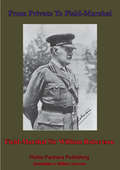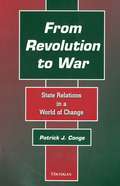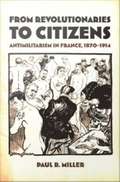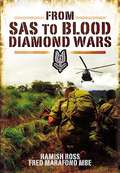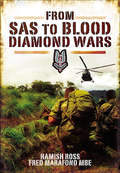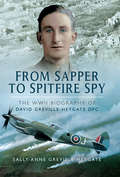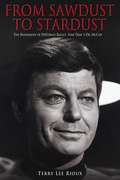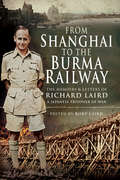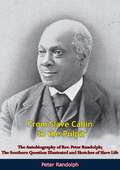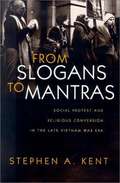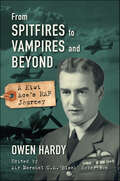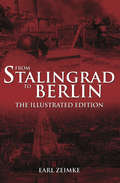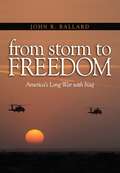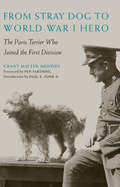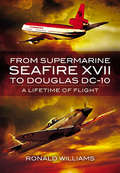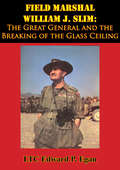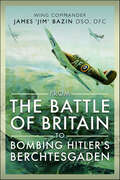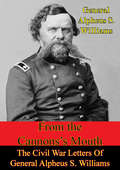- Table View
- List View
From Pigeons To Tweets: A General Who Led Dramatic Changes in Military Communications
by Hank Cox Jr. Clarence E. Mcknight Jr.General Clarence E. McKnight led the US Army into the modern age of computer warfare developing portals through which new channels of digitalizations flowed to a welcoming civilian usage. A graduate of West Point Academy, McKnight rose to the rank of Commanding General of the US Army's Signal Corps developing technology used by all the military services. McKnight was made a distinguished graduate of West Point, an uncommon honor and is being inducted into the US Army War College Museum for distinguished alumnus. This book is about military communications and how they developed strategies over the years to what we now use in the most advanced technology, science and engineering.
From Private To Field-Marshal
by Field-Marshal Sir William Robertson, bart., G.C.B., G.C.M.G., K.C.V.O., D.S.O."Scarlet coat to red-tabsIt is a common aspect of uncommon men that their lives are so exceptional that they cannot be adequately described in a few words. So much the better then that the author of this autobiography left posterity his remarkable life story.William 'Wully' Robertson was born in Lincolnshire in 1860 and became a servant in the household of the Earl of Cardigan. In 1877 he decided upon a military career and enlisted as a trooper in the 16th (The Queen's) Lancers. He proved to be an outstanding soldier and encouraged by friends and especially the officers of his regiment, Robertson earned a commission in 1888. This was an incredible achievement at the time since only four or five 'rankers' were so promoted annually. Robertson transferred to the 3rd Dragoon Guards. Having no private means Robertson struggled to maintain the lifestyle of a Victorian cavalry officer and had to work hard to generate extra income. A posting to India gave him the opportunity to do so through proficiency in languages. By 1895 he was a captain serving in the Chitral Campaign and in 1998 attended the staff college at Camberley--the first 'ranker' to go there.The Boer War saw further promotion and during the First World War--after service in the B. E. F.--Robertson rose to become Chief of the Imperial Staff being appointed to full general in 1916. He became a baronet in 1919 and field-marshal in 1920-the first man who joined the British Army at its lowest rank and by his own abilities achieved its highest rank.This is nothing less than a fascinating account, touching as it does on many aspects of military life as well as minor campaigns and major conflicts of the late 19th and early 20th centuries. Recommended."--Leonaur Print VersionAuthor -- Field-Marshal Sir William Robertson, bart., G.C.B., G.C.M.G., K.C.V.O., D.S.O., 1860-1933Text taken, whole and complete, from the edition published in London, Constable and company ltd., 1921.Original Page Count - xix and 396 pages.Illustrations - 1 Portrait.
From Revolution to War: State Relations in a World of Change
by Patrick J. CongeIn the history of international relations, few events command as much attention as revolution and war. Over the centuries, revolutionary transformations have produced some of the most ruinous and bloody wars. Nevertheless, the breakdown of peace in time of revolution is poorly understood. Patrick Conge offers a groundbreaking study of the relationship between war and revolution. How can we best understand the effect of revolutionary transformations on the politics of war and peace? Conge argues that it is only by bringing in, first, the organizational capacity of revolutionary regimes to extract resources and convert them into military strength and, second, the power of transformative ideas to transcend national boundaries and undermine the ability of opposing regimes to compromise that we are best able to understand the effect of revolution on the origins and persistence of war. By incorporating such key elements, this book provides a new, more comprehensive explanation of the relationship between revolution, war, and peace. Conditions that lead to and sustain wars in general are identified and placed in the light of revolutionary transformations. Once the argument is presented, historical case studies are used to test its plausibility. Conge demonstrates the importance of the effect of revolutionary organization and ideas on the outcome of conflicts. Political scientists, historians, sociologists, and the general reader interested in the politics of war and peace in revolutionary times are given new perspectives on the relationship between revolution and war as well as on the implications of political organization for military power and the process of consolidation of new regimes.
From Revolutionaries to Citizens: Antimilitarism in France, 1870-1914
by Paul B. MillerFrom Revolutionaries to Citizens is the first comprehensive account of the most important antiwar campaign prior to World War I: the antimilitarism of the French Left. Covering the views and actions of socialists, trade unionists, and anarchists from the time of France's defeat by Prussia in 1870 to the outbreak of hostilities with Germany in 1914, Paul B. Miller tackles a fundamental question of prewar historiography: how did the most antimilitarist culture and society in Europe come to accept and even support war in 1914? Although more general accounts of the Left's "failure" to halt international war in August 1914 focus on its lack of unity or the decline of trade unionism, Miller contends that these explanations barely scratch the surface when it comes to interpreting the Left's overwhelming acceptance of the war. By embedding his cultural analysis of antimilitarist propaganda into the larger political and diplomatic history of prewar Europe, he reveals the Left's seemingly sudden transformation "from revolutionaries to citizens" as less a failure of resolve than a confession of commonality with the broader ideals of republican France. Examining sources ranging from police files and court records to German and British foreign office memos, Miller emphasizes the success of antimilitarism as a rallying cry against social and political inequities on behalf of ordinary citizens. Despite their keen awareness of the bloodletting that awaited Europe, he claims, antimilitarists ultimately accepted the war with Germany for the same reason they had pursued their own struggle within France: to address injustices and defend the rights of citizens in a democratic society.
From Runway to Orbit: Reflections of a NASA Engineer
by Kenneth W. Iliff Curtis L. PeeblesIn this remarkable memoir, Dr. Kenneth W. Iliff—the recently retired Chief Scientist of the NASA Dryden Flight Research Center—tells a highly personal, yet a highly persuasive account of the last forty years of American aeronautical research. His interpretation of events commands respect, because over these years he has played pivotal roles in many of the most important American aeronautics and spaceflight endeavors. Moreover, his narrative covers much of the second half of the first 100 years of flight, a centennial anniversary being celebrated this year.Dr. Iliff’s story is one of immense contributions to the nation’s repository of aerospace knowledge. He arrived at the then NASA Flight Research Center in 1962 as a young aeronautical engineer and quickly became involved in two of the seminal projects of modern flight, the X-15 and the lifting bodies. In the process, he pioneered (with Lawrence Taylor) the application of digital computing to the reduction of flight data, arriving at a method known as parameter estimation, now applied the world over. Parameter estimation not only enabled researchers to acquire stability and control derivatives from limited flight data, but in time allowed them to obtain a wide range of aerodynamic effects. Although subsequently involved in dozens of important projects, Dr. Iliff devoted much of his time and energy to hypersonic flight, embodied in the Shuttle orbiter (or as he refers to it, the world’s fastest airplane). To him, each Shuttle flight, instrumented to obtain a variety of data, represents a research treasure trove, one that he has mined for years.This book, then, represents the story of Dr. Ken Iliff’s passion for flight, his work, and his long and astoundingly productive careen. It can be read with profit not just by scientists and engineers, but equally by policy makers, historians, and journalists wishing to better comprehend advancements in flight during the second half of the twentieth century.
From SAS to Blood Diamond Wars
by Hamish Ross Fred Marafono<p>On the point of being demobbed from the SAS, Fred Marafono was recruited by David Stirling for his private security company. After Stirling’s death, Fred found himself in the midst of Sierra Leone’s Blood Diamond wars, and formed an unbreakable bonding with the country’s champion of democracy, Chief Hinga Norman, whose leadership and tragic death are integral to the story. <p>Fred was recruited by Simon Mann for the finest of all private military companies in Africa, Executive Outcomes. Fewer than two hundred of them defeated the rebels in their strongholds. Through political weakness, Executive Outcomes were made to leave the country, and chaos ensued. Committed men like Hinga Norman and British High Commissioner Peter Penfold saw that in the absence of military commitment from the west, only high caliber mercenaries would win the fight to restore democracy: three of them kept a vital air bridge open − ‘What God abandoned, these defended’. Fred’s final action was supporting the SAS in their brilliant hostage release, ‘Operation Barras.’ <p>Peter Penfold sums it all up in the book’s foreword, writing of the, ‘confidence, trust and admiration I have for this remarkable man.’</p>
From SAS to Blood Diamond Wars
by Hamish Ross Fred MarafonoAlcibiades is one of the most famous (or infamous) characters of Classical Greece. A young Athenian aristocrat, he came to prominence during the Peloponnesian War (429-404 BC) between Sparta and Athens. Flamboyant, charismatic (and wealthy), this close associate of Socrates persuaded the Athenians to attempt to stand up to the Spartans on land as part of an alliance he was instrumental in bringing together. Although this led to defeat at the Battle of Mantinea in 418 BC, his prestige remained high. He was also a prime mover in Athens' next big strategic gambit, the Sicilian Expedition of 415 BC, for which he was elected as one of the leaders. Shortly after arrival in Sicily, however, he was recalled to face charges of sacrilege allegedly committed during his pre-expedition reveling. Jumping ship on the return journey, he defected to the Spartans.Alcibiades soon ingratiated himself with the Spartans, encouraging them to aid the Sicilians (ultimately resulting in the utter destruction of the Athenian expedition) and to keep year-round pressure on the Athenians. He then seems to have overstepped the bounds of hospitality by sleeping with the Spartan queen and was soon on the run again. He then played a devious and dangerous game of shifting loyalties between Sparta, Athens and Persia. He had a hand in engineering the overthrow of democracy at Athens in favor of an oligarchy, which allowed him to return from exile, though he then opposed the increasingly-extreme excesses of that regime. For a time he looked to have restored Athens' fortunes in the war, but went into exile again after being held responsible for the defeat of one of his subordinates in a naval battle. This time he took refuge with the Persians, but as they were now allied to the Spartans, the cuckolded King Agis of Sparta was able to arrange his assassination by Persian agents.There has been no full length biography of this colorful and important character for twenty years. Professor Rhodes brings the authority of an internationally recognized expert in the field, ensuring that this will be a truly significant addition to the literature on Classical Greece.
From SOE Hero to Dressing the Queen: The Amazing Life of Sir Hardy Amies
by Lynda RowlandThe biography of one of Britain’s foremost fashion designers who led a fascinating double life as a couturier and an intelligence officer during the Second World War. Sir Hardy Amies was one of Britain’s foremost fashion designers who led a fascinating double life as a couturier and an intelligence officer during the Second World War. Sir Hardy’s work for the Belgian resistance effort as part of the Special Operations Executive, was so significant that he was awarded l’Ordre de la Couronne, or Order of the Crown, by the Belgian Government in 1948. Not only did Sir Hardy conduct these operations, but he also simultaneously developed his burgeoning fashion business through the British Board of Trade’s drive to promote UK manufacturing throughout the conflict. He was a man who at once epitomized and challenged the reality of being gay in an era when society was deeply unaccepting. He was thrust into what was an overtly macho and potentially hostile environment and, against that backdrop, made a valuable and courageous contribution to the war effort. Born into what we would consider a lower middle-class family, he was handsome, cultured and gregarious and effortlessly traversed the post-war world of high society, launching his haute couture house to great acclaim, gaining clients ranging from film stars to royalty. His work for Queen Elizabeth II saw him awarded the CVO in 1977 and this was elevated to the KCVO, Knight Commander of the Victorian Order in 1989. Her Majesty’s warmth of feeling towards Sir Hardy is evident in the many hand-written thank-you letters she sent him over the course of their long working relationship. Sir Hardy, who lived until the age of 93, could have been dismissed as a lightweight character from the frivolous world of fashion. However, despite a not-particularly extensive formal education, he was highly intelligent, extremely well-traveled and spoke three languages, and his story encapsulates the extraordinary cultural and societal turbulence of the twentieth century.
From Salerno To Rome: General Mark W. Clark And The Challenges Of Coalition Warfare
by Major Glenn L. KingOn 9 September 1943 the United States Fifth Army landed at Salerno, commencing a lengthy and costly campaign that would transit the Italian Peninsula. Lieutenant General Mark W. Clark commanded this army. His many supporters, including Winston Churchill and General Dwight D. Eisenhower, considered him a brilliant staff officer and trainer. His detractors, including General George S. Patton, considered him overly ambitious and self serving. Clark had been promoted ahead of many senior and experienced officers, some of whom were now his subordinate commanders within the Fifth Army. His army would come under the jurisdiction of the Fifteenth Army Group, a combined American-British Headquarters commanded by General Harold Alexander, an Englishmen. Clark would command a number of foreign troops, including the British X Corps, the New Zealand Corps and the French Expeditionary Corps. Throughout this campaign, Clark would face the complexities of coalition command, tactical in nature but with strategic consequences. This thesis contends that the command arrangements within Fifteenth Army Group, together with biased perceptions, greatly influenced the decision making of General Clark, an accomplished staff officer yet inexperienced army commander.
From Sapper to Spitfire Spy: The WWII Biography of David Greville-Heygate DFC
by Sally-Anne Greville HeygateDavid Greville-Heygate was one of the few men who served in both the army and the Royal Air Force during the Second World War, but it was in the sky that he really earned his stripes. Stalking the skies flying photo-reconnaissance missions with No. 16 Squadron over Northern France, he was to win the illustrious and highly coveted Distinguished Flying Cross (DFC). Another highlight saw him in action in the skies above the French coastline in preparation for the D-Day landings, taking photographs that would provide the allies with essential intelligence upon which to base their plans. Based in Holland in December 1944, David flew armed recces with No.168 Squadron then transferred to No.2 Squadron where he reported on troop movements behind German lines. During the course of a dynamic and eventful career, he flew a wide variety of iconic wartime aircraft including Lysanders, Mustangs, Typhoons and Spitfires in England, the Netherlands and Germany.Although there have been many stories about the Battle of Britain there has been less published about the life of a photo reconnaissance pilot during this time. David's thrilling exploits in the sky and the part he played within the context of the wider war are enlivened here to great effect by his daughter, Sally-Anne Greville Heygate, herself a professional photographer. Using snippets from diary entries, letters, logbooks, squadron records and other documents, she has managed to construct an engaging history of a talented photo-reconnaissance pilot and the war in which he fought.
From Sarajevo With Sorrow
by Goran Simic Amela SimicFrom Sarajevo, with Sorrow restores all that is offensive, despairing and necessary to our understanding of war by capturing the poems' original power and humanity. This collection contains both previously unpublished poems, written "under the candlelight" of the siege, and new poems returning to the sniper's alleys and bunkers of Sarajevo. This is a disturbingly resonant, timely and important collection.
From Sawdust to Stardust: The Biography of DeForest Kelley, Star Trek's Dr. McCoy (Star Trek)
by Terry Lee RiouxIn the forty-year history of Star Trek®, none of the television show's actors are more beloved than DeForest Kelley. His portrayal of Leonard "Bones" McCoy, the southern physician aboard the Starship Enterprise , brought an unaffected humanity to the groundbreaking space frontier series. Jackson DeForest Kelley came of age in Depression-era Georgia. He was raised on the sawdust trail, a preacher's kid steeped in his father's literal faith and judgment. But De's natural artistic gifts called him to a different way, and a visit to California at seventeen showed a bright new world. Theater and radio defined his early career -- but it was a World War II training film he made while serving in the Army Air Corps that led to his first Paramount Studios contract. After years of struggle, his lean, weathered look became well known in notable westerns and television programs such as You Are There and Bonanza. But his work on several pilots for writer-producer Gene Roddenberry changed his destiny and the course of cultural history. This thoroughly researched actor's life is about hard work and luck, loyalty and love. It is a journey that takes us all...from sawdust to stardust.
From Shanghai to the Burma Railway: The Memoirs & Letters of Richard Laird, A Japanese Prisoner of War
by Rory LairdA graphic record of one man’s experience in an infamous POW camp during World War II, and how he survived being forced to build the “Death Railway.”Captured after fighting in the Malayan Campaign, Richard Laird was incarcerated in Changi before being drafted as slave labor with “F” Force on the notorious Burma Railway. He was one of only 400 out of 1600 to survive Songkurai No. 2 Camp, despite disease and terrible hardship. His moving memoir begins with a rare description of ex-patriate life in 1930s Shanghai with the Sino-Japanese war raging around the European cantonments. An additional dimension to his story is the developing relationship between the author and Bobbie Coupar Patrick to whom he became engaged shortly before the fall of Singapore. Bobbie’s letters graphically described her dramatic escape to Australia and work for Force 136. They were reunited in Colombo, Ceylon and their son has been instrumental in compiling this exceptional record. Three appendices round off this superb book including the official report on the hardships and losses suffered by “F” Force.“A compelling story that deserves to be widely read.” —Firetrench
From Siege to Surgical: The Evolution of Urban Combat from World War II to the Present and Its Effect on Current Doctrine
by Major William T. James Jr.This study investigates what effect the evolution of urban combat from World War II to the present has had on current urban combat doctrine. Urban combat operations have played a pivotal role in the conflicts of the twentieth century, and will continue to be a crucial part of future U.S. power projection operations. It is imperative that lessons learned from previous urban combat operations be studied for applicability to current urban combat doctrine.The study analyzes the urban battles of Aachen, Manila, Seoul, Hue, JUST CAUSE, and Mogadishu to identify salient lessons for conducting successful offensive urban combat operations; then reviews current U.S. Army urban combat doctrine. The study then evaluates current doctrine using identified salient lessons to determine their effect. The study finds that the primary impacts of previous urban combat operations on current doctrine are that doctrine now embraces the idea of varied conditions for urban combat and validates the concept of fighting as a combined arms team in a built-up area. The study further finds that FM 90-10, Military Operations on Urban Terrain is obsolete, and that key procurement decisions have left U.S. forces without critical weapons that have proven decisive in urban combat.
From Slave Cabin to the Pulpit: The Autobiography of Rev. Peter Randolph (Regenerations Ser.)
by Peter RandolphPeter Randolph was born c. 1825 in Prince George County, Virginia, on the Brandon Plantation. He was enslaved upon birth and owned by Carter H. Edloe, who also held his mother and four or five siblings in bondage. Randolph's father was enslaved on a nearby plantation, and died when Randolph was approximately ten. Edloe had written a will directing that upon his death his slaves be freed and land he owned be sold, in part to pay his debts, but also to finance sending his former slaves to whichever state or colony they sought. Edloe's wishes were initially ignored by the executor of his will after he died in 1844. However, Randolph, who was Edloe's only literate slave, read the will and began legal proceedings to fight for his freedom and that of Edloe's other slaves. Three years later, they were freed by the order of a judge.Aided in settling by the Massachusetts Anti-Slavery Society, Randolph initially lived in Beacon Hill, Boston, where he attended the Belknap Street Church, led by Leonard Grimes. He was an original member of the Twelfth Baptist Church upon its formation and was later a preacher there...By 1861 Randolph was working at a newspaper in Boston and preaching. Randolph grew to become a vocal anti-slavery advocate as a member of the Massachusetts Anti-Slavery Society, donating money and otherwise aiding enslaved people seeking freedom. He published an account of his experience with slavery, The Sketch of a Slave life, or, an illustration of the peculiar institution, in 1855, with the goal of showing "that slaves, when liberated, can take care of themselves, and need no master or overseer to drive them to their toil." Randolph died on August 7, 1897, in Boston.-Wiki.
From Slogans to Mantras: Social Protest and Religious Conversion In The Late Vietnam War Era
by Stephen A. KentThe author has sought out and interviewed many of the folks who first too part in politics and later in radical religious conversions during the sixties.
From Spitfires to Vampires and Beyond: A Kiwi Ace's RAF Journey
by Owen HardyWorld War Two Spitfire pilot Owen Hardy was probably the last New Zealand ace to tell his story. He left home at 18 bent on joining the RAF and by 1942, aged only 20, he was at Biggin Hill with 72 Squadron under Brian Kingcome. D-Day found him flying over the Normandy beaches with 485 (New Zealand) Squadron. That he survived the war unharmed owed as much to luck as it did to his ability as a fighter pilot. Unable to settle in civilian life afterwards in New Zealand, he returned to the RAF for the second phase of a remarkable career. Converting to jets, Hardy went on to command 71 Squadron, leading a Vampire aerobatic team with considerable success across Europe – dodging MiGs at the same time! But adapting to peacetime service wasn’t easy. Previously stimulated by the wartime environment and still passionate about flying, he was less enamored with staff jobs; and this despite working on the introduction of a new, state-of-the-art missile system, Bloodhound. Then a fateful decision, to turn down command of a Javelin squadron and follow his mentor, led finally to disillusionment. Hardy pulls no punches in this forthright and refreshingly honest autobiography. In retelling his eye-opening story, editor Black Robertson shines a light on what it was like not just to fly in combat, but also on the changing face of a post-war RAF which arguably undervalued some of its heroes. From the heat of North Africa to the uncertainties of the Cold War, it’s a unique and enthralling tale.
From St Vith to Victory: 218 (Gold Coast) Squadron and the Campaign Against Nazi Germany
by Stephen C. SmithCompiled from a variety of sources and first-hand accounts, this book is an authoritative record of the part played by No.218 (Gold Coast) Squadron during the bomber offensives of World War II. The squadron's activities are described in detail offering a unique insight into the lives of those involved and saluting the important role that No.3 Group and No.218 Squadron played in Bomber Command's ultimate victory.No.218 Squadron was formed a few months before the Armistice which brought to a conclusion the Great War. Disbandment soon followed, rendering the squadron number plate dormant until the rise of National Socialism in Germany. The squadron was reformed in 1936 and spent the remaining peace time years honing its skills, skills that would be tested from the very first day of the bomber offensive against Germany to the very last.
From Stalingrad to Berlin: The Illustrated Edition
by Earl ZeimkeWith scarcely an interlude, the German-Soviet conflict in World War II lasted for 3 years, 10 months, and 16 days. The conflict seesawed across eastern and central Europe between the Elbe and the Volga, the Alps, and the Caucasus. The total number of troops continuously engaged averaged between 8 and 9 million, and the losses were appalling. Wehrmacht losses numbered between 3 and 3.5 million. Deaths on the Soviet side reached more than 12 million, about 47 percent of the grand total of soldiers of all nations killed in World War II. The war and the occupation cost theSoviet Union some 7 million civilians and Germany about 1.5 million. The losses, civilian and military, of Finland, the Baltic States, and eastern and southeastern European countries added millions more.The great struggle completely unhinged the traditional European balance of power. The war consolidated the Soviet regime in Russia, and enabled it to impose the Communist system on its neighbours, Finland excepted, and on the Soviet occupation zone in Germany. The victory made the Soviet Union the second-ranking world power.This book follows the conflict from Stalingrad to Berlin. Topics include strategy and tactics, partisan and psychological warfare, coalition warfare, and manpower and production problems faced by both countries, but by the Germans in particular.With a new introduction by Emmy AwardTM winning historian Bob Carruthers and numerous rare illustrations this powerful book makes for a welcome addition to any Second World War library.
From Storm to Freedom
by John R. BallardCovering both Operation Desert Storm and Operation Iraqi Freedom as two campaigns within a single, if discontinuous, conflict, this book analyzes the strategic interaction between Iraq and the United States from 1990 to 2010 and the key operational decisions that determined the course of the war. The author's assessment of the long war against Iraq includes misunderstandings between government leaders in Iraq and the United States that led initially to war, ineffective UN sanctions, inefficient efforts by the Clinton administration, and uncoordinated actions by the Bush administration that then led to a preemptive strategy, continuation of conventional combat, and the evolution of an Iraqi insurgency.Ballard's thorough examination of these multiple operations within the context of a single conflict provides readers with rare and insightful perspectives on the complexity of modern war and the challenges of operational command. He first identifies the influence of the Vietnam era on the use of U.S. military power and the decision for war in 1990 and then outlines the important factors of Iraqi history and culture that dominated relations between the two nations during the 1980s and 1990s. Subsequent chapters examine the conduct of Desert Storm from the American and Iraqi perspectives and the military, economic, and diplomatic actions of the period between the two conventional campaigns. Final chapters analyze the 2003 offensive on Baghdad, the postwar stabilization operations that began with the failure to transition under the Coalition Provisional Authority, and the eventual implementation of a warfighting strategy that combined new doctrine and a surge of forces to protect the population in a renewed counterinsurgency campaign. A concluding chapter reviews key lessons for the future, including the importance of effective strategic decision making and the operational mindset required to prosecute modern war successfully.
From Stray Dog to World War I Hero: The Paris Terrier Who Joined the First Division
by Pen Farthing Grant Hayter-Menzies Paul E. Funk IIOn the streets of Paris one day in July 1918, an American doughboy, Sgt. Jimmy Donovan, befriended a stray dog that he named Rags. No longer an unwanted street mutt, Rags became the mascot to the entire First Division of the American Expeditionary Force and a friend to the American troops who had crossed the Atlantic to fight. Rags was more than a scruffy face and a wagging tail, however. The little terrier mix was with the division at the crucial battle of Soissons, at the Saint-Mihiel offensive, and finally in the blood-and-mud bath of the Meuse-Argonne, during which he and his guardian were wounded. Despite being surrounded by distraction and danger, Rags learned to carry messages through gunfire, locate broken communications wire for the Signal Corps to repair, and alert soldiers to incoming shells, saving the lives of hundreds of American soldiers. Through it all, he brought inspiration to men with little to hope for, especially in the bitter last days of the war. <p><p> From Stray Dog to World War I Hero covers Rags’s entire life story, from the bomb-filled years of war through his secret journey to the United States that began his second life, one just as filled with drama and heartache. In years of peace, Rags served as a reminder to human survivors of what held men together when pushed past their limits by the horrors of battle.Watch a book trailer.
From Supermarine Seafire XVII to Douglas DC-10: A Lifetime of Flight
by Ronald WilliamsRon Williams flying career started in the Royal Naval Volunteer Reserve which he joined for his National Service in the 1950s. Having completed this he became a civilian pilot and embarked on a career that would see him flying an amazing variety of aircraft in all parts of the world.His first operational naval aircraft was the Seafire XVII, a direct descendent of the Spitfire. This aircraft was capable of 480 knots, and it was during his first solo flight in one that he very nearly killed himself trying to achieve that speed. Luckily he escaped unharmed but much chastened. Whilst serving with the RNVR he also went solo on the Hawker Sea Fury, the worlds fastest piston engine at that time, and also the jet powered Attacker.Having obtained his civilian pilots licence he commenced flying DC-3s for Cambrian Airways around the UK and Europe. He then moved to a charter airline, Independent Air Travel flying the Vickers Viking, then to BlueAir flying DC-4s to Hong Kong and the Far-East. Next came Airwork based in Adelaide, still on DC-4s. A return to the UK saw him flying the Bristol Freighter from Southend Airport to the near Continent carrying passengers and their cars.Tragedy nearly struck when he was attempting to deliver a Scottish Aviation Twin Pioneer from Southend to the Cape Verde Islands. One of the legs of this flight entailed a stop-over on Fuerteventura, one of the Canary Islands. Having elected to fly at night the small twin-engined aircraft hit bad weather and became lost. Unable to make radio contact and running out of fuel he was forced to ditch into the Atlantic in the eye of a hurricane. A Spanish fishing boat was fortunately to hand and rescued Ron, his co-pilot and single passenger.A move to Eire and Air Lingus followed, captaining Boeing 707s to New York and other American cities. Then came Cathay Pacific flying the Convair 880, British Airways flying BAC 1-11s and finally a twenty year stint with British Caledonian flying DC-10s. This airline was eventually merged with British Airways.This book explains many of the practical and technical aspects of commercial flight and also the pleasurable side of Rons enforced nomadic lifestyle. The story covers commercial flight from its early post-war piston-powered infancy to current airline technology and methods.
From Teaching To Practice: General Walter Krueger And The Development Of Joint Operations, 1921-1945
by Major George B. EatonGeneral Walter Krueger commanded the 6th Army in the Southwest Pacific Theater in World War II. As the Commander, 6th Army, he led the troops that liberated New Guinea and the Philippines and he was designated as the commander of the forces scheduled to invade Japan. Krueger's wartime accomplishments were simply a continuation of contributions made to the United States Army and Navy over a 47 year career. Yet, despite his achievements, after the war Krueger simply faded away. Krueger's lack of historical name recognition some 50 years after his greatest achievements deprives current officers and historians not only the knowledge of wartime exploits, but also of significant understanding of the development of joint operations doctrine in the years between World War I and World War II.The current consensus among historians is that the United States Marine Corps was responsible for the development of amphibious operations. While true at the tactical level, this paper demonstrates that the Army and Naval War Colleges and the Army and Navy General Staffs and War Plans Divisions were key players in the development of doctrine at the strategic and operational level. General Walter Krueger attended both war colleges, served on the faculty of both war colleges, and served two tours in the Army War Plans Division, including a two year stint as its Chief. He was on the Joint Board or the Joint Planning Committee for over six years. The intent of this paper is to show Krueger's personal influence in the development of joint doctrine.The paper considers Krueger's assignment history, the war plans he developed, his ideas on unity of command and the need for inter-service understanding, and his principles of war planning. It includes a case study of the Lingayen Gulf Landing in January 1945 to demonstrate the acceptance and rejection of his key ideas. The paper focuses on Army and Navy issues and considers air issues only tangentially.
From The Battle of Britain to Bombing Hitler's Berchtesgaden: Wing Commander James 'jim' Bazin, Dso, Dfc
by James BazinIt was Tuesday, 17 October 1939. Britain had been at war with Germany for more than a month and for only the second time the Luftwaffe had dared to enter British airspace – and at last James ‘Jim’ Bazin’s chance had come. After joining the RAF in 1935, Jim was an experienced pilot when war broke out and he was eager to test his skills against the enemy. This first combat was the start of a career which saw Wing Commander Bazin, as he was to become, being posted to France with 607 (County of Durham) Squadron. He fought there until the last days of the Battle of France. In the course of the campaign, Bazin had battled his way to becoming an ace. He was also shot down behind enemy lines, but successfully evaded capture to return to his squadron and resume the fight. There was no respite for Bazin as he was once again in the air defending Britain’s skies in his trusty Hurricane as the Luftwaffe sort to destroy Fighter Command in the summer of 1940. With ten ‘kills’ to his name, Jim Bazin was awarded the Distinguished Flying Cross in October that year. But merely driving off the Luftwaffe was not enough for him. He was posted to Inverness where he served as a Controller in 14 Group’s Operations Room, which gave him a taste for offensive operations. In time, Bazin volunteered to move to Bomber Command. He duly undertook a conversion course in 1943, eventually joining 49 Squadron as a Lancaster pilot to take the war to the very heart of the enemy. After commanding 49 Squadron, including taking part in Bomber Command’s support of the D-Day landings, Bazin was promoted to Wing Commander, leading 9 Squadron on many attacks on special targets such as U-boat pens, viaducts, refineries and, most notably, operating with the famous Dambusters against Hitler’s great battleship Tirpitz. Unrelenting in his efforts against the enemy, Jim Bazin was involved in operations against targets in Poland and Germany right up until the end of the war. This culminated in the last major RAF operation of the Second World War when, on 25 April 1945, Bomber Command attacked the Berghof, Hitler’s Alpine retreat, and other targets in Berchtesgaden. Jim Bazin was awarded the DSO in September 1945 – rightful recognition for a man who had done so much to bring about the defeat of the enemy.
From The Cannon’s Mouth: The Civil War Letters Of General Alpheus S. Williams
by Milo M. Quaife General Alpheus S. WilliamsA candidate for the title of "unsung hero" among the Union generals of the Civil War, Alpheus Williams, "Old Pap" to his men, wrote as frequently as he could to his family in Detroit of his successes, achievements and battles during that terrible period of strife. In this engaging collection of his correspondence he recounts the part he played in the battles both East and West at Second Bull Run, Antietam, Chancellorsville, Gettysburg, Atlanta and the Savannah campaign. A kind hearted man, he was deeply affected by the hardships suffered by the common soldiers under his command who he treated with great care and often sorrow at the awful casualties they suffered.Warmly recommended."Superb war letters. . . . Old 'Pap' Williams possessed an unconscious literary flair that gives simple style and force to his letters. . . . Milo Quaife has added annotation that will enlighten the casual reader and satisfy the scholar."--New York Times Book Review"Civil War scholars are always grateful for a volume of letters written by a high-ranking officer who held important commands in pivotal engagements. . . . A superior collection. . . . Especially useful to students of the war are his keen, detailed accounts of Antietam, Chancellorsville, and Gettysburg."--American Historical Review

